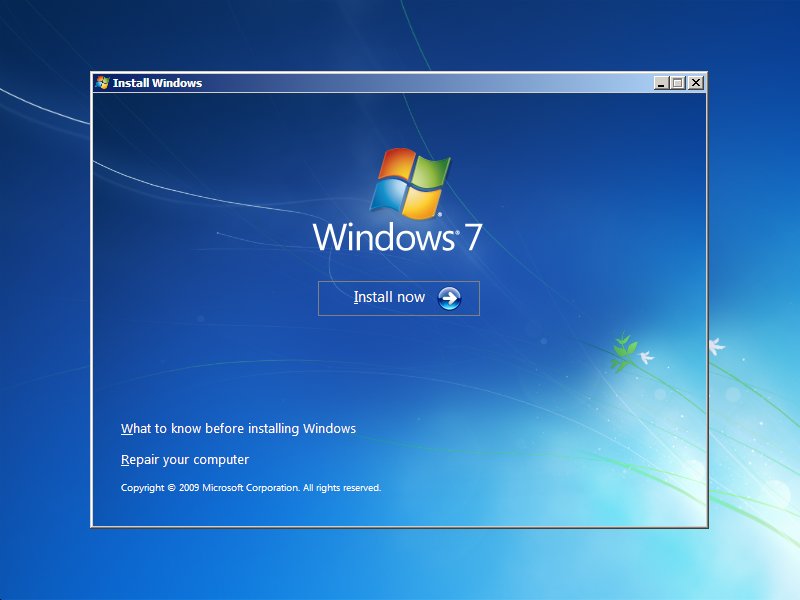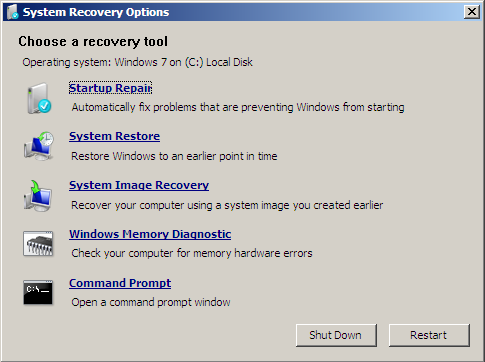Get the fix for the error STOP: 0x0000006B PROCESS1_INITIALIZATION_FAILED on Windows XP, Windows Vista, Windows 7, Windows 8, Windows 8.1 and Windows 10.
Contents
About the “0x0000006B” error
The following information on this error has been compiled by NeoSmart Technologies, based on the information gathered and reported by our global network of engineers, developers, and technicians or partner organizations.
Description and Symptoms
The error messages, alerts, warnings, and symptoms below are tied to this error.
Symptom 1: 0xc000006b error screen on startup
The ntdll.dll file is a library created by Microsoft that basic contains NT kernel functions. It is required by the system to load properly, and it must be located in the %windir%/system32 folder. If it is missing or corrupt, then the 0x0000006b error screen appears.
Here is an example of an error screen that appears on Windows XP, Vista, and Windows 7
A problem has been detected and Windows has been shut down to prevent damage to your computer. PROCESS1_INITIALIZATION_FAILED If this is the first time you’ve seen this Stop error screen, restart your computer. If this screen appears again, follow these steps: Check to make sure any new hardware or software is properly installed. If this is a new installation, ask your hardware or software manufacturer for any Windows updates you might need. If problems continue, disable or remove any newly installed hardware or software. Disable BIOS memory options such as caching or shadowing. If you need to use Safe Mode to remove or disable components, restart your computer, press F8 to select Advanced Startup Options, and then select Safe Mode. Technical Information: *** STOP: 0x0000006B (0x00000034, 0x00000002, 0x00000000, 0x00000000)
And here is an example of an error screen that appears on Windows 8, Windows 8.1 and Windows 10:
Your PC ran into a problem and needs to restart. We're just collecting some error info, and then we'll restart for you(80% complete) If you'd like to know more, you can search online later for this error: PROCESS1_INITIALIZATION_FAILED
Symptom 1: 0xc000006b error screen on Windows 7 or Windows Server 2008 R2
On Windows 7 with no Service Packs installed, or on Windows Server 2008 R2, this error is often caused because the Bootcat.cache file is corrupted or because the size of the Bootcat.cache file is changed since the last successful start. This error is fixed in Service Pack 1 for both Windows 7 and Windows Server 2008 R2.
Causes of this Error
This error has been known to occur as a result of one or more of the following:
Cause 1: NTDLL.dll file is missing or corrupt
The NTDLL.dll file, located at %windir%/system32 is a vital component of Windows boot process, and the system cannot work properly if it is corrupt or missing. This may happen because of disk read/write errors, virus attacks, or power outages.
Cause 2: Bootcat.cache file is corrupt
On Windows 7 and Windows 2008 R2 with no Service Packs installed, this error is caused because the Bootcat.cache file is corrupted or its size was changed. If that’s the case, the user should either delete this file manually, or install the latest Service Pack provided by Microsoft
Fixing “0x0000006B” on Windows
Windows Setup CD/DVD Required!
Some of the solutions below require the use of the Microsoft Windows setup CD or DVD. If your PC did not come with a Windows installation disc or if you no longer have your Windows setup media, you can use Easy Recovery Essentials for Windows instead. EasyRE will automatically find and fix many problems, and can also be used to solve this problem with the directions below.
Fix #1: Replace the DLL
If ntdll.dll is in fact missing or corrupt, you can restore the original ntdll.dll file back from your Windows XP installation disc.
Unable to boot into the Windows setup CD?
See our guide on setting up a PC to boot from the CD or DVD for troubleshooting and more detailed instructions.
- Insert your XP CD into the computer.
- Restart your computer.
- Press any key to boot into the CD when you see the “Press any key to boot from CD” message.
- Press R to start Recovery Console when the Options screen appears.
- Type in your Administrator password followed by the Enter key to submit it.
- You’ll reach the Command Prompt now, type the following command, where
D:\is your CD’s drive letter andC:\is the letter of the drive you installed Windows to:copy D:\i386\ntdll.dll C:\Windows\system32\ntdll.dll
- Press Y when you are asked if you want to overwrite this file and then hit Enter to submit the command.
- Restart your computer.
Here is an example of what the PC’s console output should look like once the ntdll.dll file is properly restored:
Fix #2: Use Startup Repair to attempt NTDLL replacement
On Windows Vista, Windows 7, Windows 8 and Windows 8.1, Startup Repair can be used to scan the system for damaged or missing system files to replace the ntdll.dll file if it is corrupt or missing.
Windows Setup CD/DVD Required!
Some of the solutions below require the use of the Microsoft Windows setup CD or DVD. If your PC did not come with a Windows installation disc or if you no longer have your Windows setup media, you can use Easy Recovery Essentials for Windows instead. EasyRE will automatically find and fix many problems, and can also be used to solve this problem with the directions below.
Startup Repair is an automated diagnosis and repair tool that is available from the Windows setup disc and can be used to find and repair some common problems. More information about how Startup Repair operates and what it does can be found in our knowledgebase. The following steps will initiate Startup Repair from the Windows setup disc:
Unable to boot into the Windows setup CD?
See our guide on setting up a PC to boot from the CD or DVD for troubleshooting and more detailed instructions.
- Insert your Windows installation DVD into your PC’s CD-ROM drive,
- Fully power down your PC, and make sure it has fully shut off,
- Power up your PC,
- Press any key when you see “Press any key to boot from CD or DVD..”
- Click the link titled “Repair your computer” in the bottom-lefthand corner, after first selecting your language and keyboard options.

- Wait for Startup Repair to scan your PC for Windows installations, then select your install from the list it shows:

- Choose “Startup Repair” from the list of available recovery options to begin:

- Startup Repair will begin scanning your installation for known issues and will attempt a repair, if possible.

Here is an example of what the PC’s startup repair should look like once the ntdll.dll file is properly restored:
Fix #3: Repair corrupted system files with the SFC command
On Windows Vista, Windows 7, Windows 8 and Windows 8.1, it is possible to use the built-in Windows SFC(system file checker) tool to automatically scan a computer’s system files and repair them if necessary.
Here are the steps to run SFC:
- Boot from your Windows install disc
- Click on Repair your computer after selecting proper language, time and keyboard input.
- Select the Windows installation drive, which is usually
C:\, and click Next - Choose Command Prompt when the System Recovery Options box appears
- Write the following command and press Enter afterwards:
sfc /scannow /offbootdir=D:\ /offwindir=D:\Windows\
Replace D: with the letter of the driver where Windows is installed, and D:\Windows with the Windows folder location.
Here is an example of what the PC’s console output should look like once the sfc.exe scan is complete and missing files are successfully restored:
Fix #4: Delete Bootcat.cache and Install SP1
If the error is caused by a corrupt Bootcat.cache file, it is possible to delete it manually and install the Service Pack to fix this error once the system loads successfully. To do so, follow these steps:
- Insert the Windows 7 installation DVD
- Restart the computer
- Boot from the DVD
- At the Install Windows screen, select Repair your computer or press R

- At the System Recovery Options screen, select Command Prompt

- When Command Prompt appears, type the letter of the drive where your Windows 7 is installed:
D:
Replace
D:with the letter of the drive where Windows 7 is installed, ifD:is not your default installation drive. - Press Enter
- Then type:
cd windows\system32\codeintegrity
- Press Enter
- Type:
del bootcat.cache
- Press Enter
- Restart your computer
Here is an example of what the PC’s console output should look like once the bootcat.cache file is deleted:
After your computer loads successfully, follow these steps to install the Service Pack:
- Click Start
- Click All Programs
- Click Windows Update
- Click Check for updates
- Select Service Pack for Microsoft (KB976932)
- Click OK
- Click Install Updates
- Type the Administrator password, when prompted
- Follow the instructions on the screen to complete the installation
Fix #5: Check the hard drive with CHKDSK utility
If the hard drive has its file integrity compromised, it is possible to use built-in Windows CHKDSK utility to scan the disk and fix the file system errors.
Here are the steps to run CHKDSK:
- Boot from your Windows install disc
- Click on Repair your computer after selecting proper language, time and keyboard input.
- Select the Windows installation drive, which is usually
C:\, and click Next - Choose Command Prompt when the System Recovery Options box appears
- Write the following command and press Enter afterwards:
chkdsk C: /f
Replace C: with the letter of the driver where Windows is installed.
Here is an example of what the PC’s console output should look like once the chkdsk.exe is complete:
More Information
Linked Entries
Support Links
- Easy Recovery Essentials for Windows – our repair and recovery disk.
It’s an easy-to-use and automated diagnostics disk. It’s available for Windows 8, Windows 7 and Windows Vista. It’s also available for Windows XP and Windows Server.Read more at Windows Recovery Disks.
- The NeoSmart Support Forums, member-to-member technical support and troubleshooting.
- Get a discounted price on replacement setup and installation discs: Windows XP, Windows Vista, Windows 7, Windows 8, Windows 10.
Applicable Systems
This Windows-related knowledgebase article applies to the following operating systems:
- Windows XP (all editions)
- Windows Vista (all editions)
- Windows 7 (all editions)
- Windows 8 (all editions)
- Windows 8.1 (all editions)
- Windows 10 (all editions)





